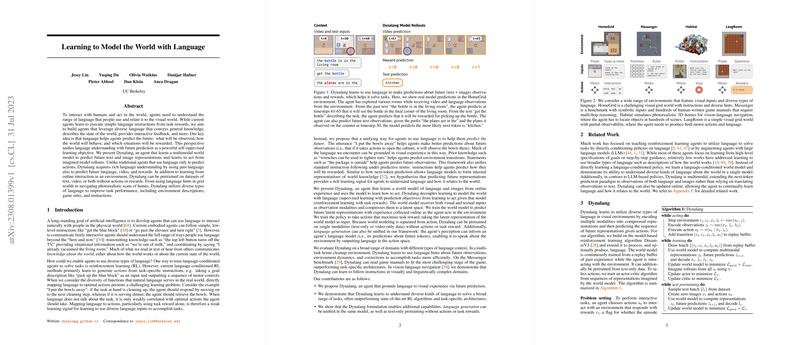Learning to Model the World with Language: An Expert Overview
This paper titled "Learning to Model the World with Language" by Jessy Lin et al. presents a substantive advancement in the development of multimodal agents capable of understanding and utilizing diverse language inputs to predict future states in interactive environments. The central contribution is the introduction of Dynalang, an agent that integrates visual and linguistic modalities to build a world model that can predict future text and image representations, informing action selection in a self-supervised manner.
Core Contributions
The key contributions of the paper are manifold:
- Dynalang Architecture: Dynalang employs a multimodal world model that learns to encode visual and textual inputs into a shared latent representation space. This model predicts the future states of the environment based on past observations and actions, enabling the agent to plan and act within its environment more effectively.
- Learning to Predict Future States: Rather than mapping language directly to actions as done in traditional RL approaches, Dynalang leverages language to predict future states. This future prediction objective serves as a potent self-supervised learning signal, enhancing the agent's ability to ground language in visual experience and task performance.
- Dynamic Action and Text Prediction: Dynalang can also act based on imagined rollouts from the world model and can be pretrained on text-only or video-only datasets, enabling flexibility in learning from various forms of offline data. The architecture supports both motor action predictions and language generations, illustrating its versatile applicability across different tasks.
- Empirical Evaluation: The efficacy of Dynalang is rigorously evaluated across several tasks, demonstrating superior performance compared to model-free RL baselines such as IMPALA and R2D2. It's particularly noteworthy in its ability to use diverse kinds of language inputs—future observations, dynamic descriptions, corrections—to improve task performance significantly.
Experimental Insights
The experiments showcase Dynalang's utility in a range of settings:
- HomeGrid: This novel environment explicitly tests the agent's ability to use various forms of language inputs. The results illustrate Dynalang's superior performance in integrating task instructions with additional contextual language, which model-free RL baselines struggled with.
- Messenger Benchmark: Dynalang outperforms task-specific architectures such as EMMA by effectively using game manuals to navigate complex game states, demonstrating the strength of the proposed future prediction-based grounding.
- Vision-Language Navigation (VLN-CE): The agent successfully learns to follow natural language navigation instructions in photorealistic environments, providing evidence that future reward prediction based on grounded language can be as effective as traditional instruction-following models.
- LangRoom: Here, Dynalang illustrates its capacity for language generation, answering questions based on observed environmental states, further showcasing its multimodal integration and planning capabilities.
Implications and Future Directions
The theoretical and practical implications of this research are profound. Dynamically integrating linguistic inputs with visual data via future prediction broadens the horizons for more intuitive and interactive AI systems in complex real-world applications. This work lays the groundwork for developing agents that can seamlessly interact with humans by understanding and predicting both language and environmental changes.
Future research directions could include:
- Scalability: Exploring more scalable architectures that can handle longer horizon tasks and sequences, potentially leveraging transformer-based models for sequence modeling.
- Enhanced Pretraining: Further exploiting large-scale pretraining on vast multimodal datasets to improve initial world model training efficiency and generalization.
- Advanced Interactivity: Introducing more complex, open-ended tasks that require nuanced reasoning about language and visual inputs, closer to real-world interaction scenarios.
The paper avoids sensational language and adopts a formal, meticulous academic tone, ensuring clarity and precision in presenting its findings. This restraint is beneficial for fostering a robust and objective understanding of the contributions without superfluous embellishments.
In conclusion, Dynalang represents a significant step in the evolution of multimodal agents, showcasing the potential of future prediction as a unified learning objective for grounding language in interactive AI systems.
